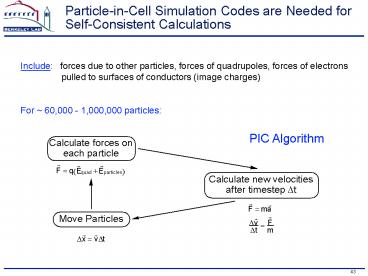ParticleinCell Simulation Codes are Needed for SelfConsistent Calculations - PowerPoint PPT Presentation
1 / 25
Title: ParticleinCell Simulation Codes are Needed for SelfConsistent Calculations
1
Particle-in-Cell Simulation Codes are Needed for
Self-Consistent Calculations
Include forces due to other particles, forces
of quadrupoles, forces of electrons
pulled to surfaces of conductors (image
charges) For 60,000 - 1,000,000 particles
PIC Algorithm
2
Particle in Cell Simulations Show Emittance
Growth for Off-center Beam
3
(No Transcript)
4
(No Transcript)
5
The MBE-4 Accelerator
6
The High Current Experiment (HCX)
The High Current Experiment transports 1
Driver-scale beam.
K 0.2 - 0.5 Amp 1 - 1.7 MeV 4.5 - 7 ms
10 (30-40 later) electrostatic quadrupoles 4
pulsed normal magnetic quads
(a few) superconducting quads
Issues to be resolved Dynamic aperture
(usable aperture set by dynamics) Halo
production Effect of desorbed gas on
tail Electron production orbits (magnetic
transport) Steering - frequency needed
How much beam can be transported?
7
High-Current Experiment (HCX) first transport
experiment using a driver-scale heavy-ion beam
Injector
Matching Section
Diagnostics
Source
Transport Section
Diode
ESQ Accelerator
8
High Current Experiment (HCX) began operation
January 11, 2002.
Transport - aperture limits - electrons -
gas effects - halo formation - steering
Marx
ESQ injector
matching
diagnostics
10 ES quads
diagnostics
9
The HCX will investigate electron effects
electron born
Electron in magnetic field constrained
radially and azimuthally to follow field
lines, axially to drift at sum of E x B and
?B velocities. Electron, accelerated to
energy greater than beam potential, is lost
to wall. Then electron lifetime drift time
in magnetic quadrupole
electron strikes wall yielding secondaries
(orbit computed using WARP code)
10
Issues at the Final Focus
- Geometric aberrations
- particles on outside of beam have different
focal length - Chromatic aberrations
- particles with more energy feel less focusing
- Neutron damage
- Neutralization
- Other methods?
- plasma lens, z-pinch
11
Multiple jets can create thick liquid pockets
Thick Fluids
FLiBe fluorine, lithium, beryllium
12
Beam Dynamics Chamber Issues
- Neutralization dynamics
- Stripping
- Photoionization from target x-rays
- Instability
13
Neutralized Transport Experiment at LBNL
PPPL ECR plasma source flexible plasma gradient
of nplasma
Existing 400 kV injector
Final-focusing optical system
FY02 characterize ion plasma
sources FY03 study beam aberrations FY04
complete initial neutralization experiments
14
Plasma Plug simulation (LSP code)
- Electrons are dragged along by ion beam
- Effective neutralization fraction 94
K
e-
15
Chamber Transport Show the Effects of
aBackground Plasma
Unneutralized Charge deflects higher charge state
ions.
- No plasma
1013 cm-3 plasma
Plasma prevents beam deflection until z200 cm
where nb/np 1
D. A. Callahan, Fusion Eng. Des. 32-33, 441
(1996)
16
First Beam through Neutralized Drift Section with
Plasma Plug (September, 2002)
Without Plasma
Magnetic section
With Plasma
Pulsed arc plasma source
Drift tube
Scintillating glass
17
ECR Plasma Source will be installed at NTX late
September (volumetric plasma and gas effects)
18
Many parts of driver physics (will) have been
demonstrated, but not in an integrated way
a few kilometers
Target
Multiple Beam Ion Source and Injector
Acceleration with electric focusing
Acceleration with magnetic focusing
Chamber Transport
focusing
Injection Matching
Longitudinal compression
Bending
19
The Future The Integrated Beam Experiment
80 M
- Source to target demonstration ( 5-10 MeV)
- 1 Beam (maybe upgradeable to more)
- First experiments on
- Long transport
- Drift compression
- Bending of intense beams
- Longitudinal stability beam quality
- Integrated source-to-focus transport
acceleration - Benchmark simulations for design of future
expts
20
Present Future Program
Integrated Beam Experiment
21
Far Future The Integrated Research Experiment
(IRE) will test all components physics for an
ETF
Acceleration Electrostatic Focusing
400 - 800 MeV 30-200 kJ on target 300 - 500
m 150 - 300 M
32 - 100 beams
Target physics symmetry of implosion dE/dx
22
Physics for the IRE
- Multiple beam physics
- inductive effects at high energy
- interaction with neutralizing electrons in
chamber - Effect on longitudinal stability of interaction
of beam with induction cores drive
circuitry (beam loading) - Effect of electron accumulation in pulse
- Long length scale emittance growth
- retest of physics on IBX with high sensitivity
- Beamtarget interaction physics implosion
symmetry
23
The Endgame
- Engineering Test Facility
- Test driver, perhaps with multiple target
chambers - Upgrade to power plant driver?
- Power Plant Driver
24
Summary
- Heavy ion fusion is a small program trying to
make use of the efficiency, reliability,
and simplicity of heavy ion accelerators to
make commercial electric power from seawater - The present design for a power plant driver
is an induction linear accelerator which uses
quadrupole focusing - The physics of the beam particle orbits is
determined by the collective interaction of
the particles with each other and with external
focusing and accelerating forces-- a very hard
and interesting problem requiring large
supercomputers - Small scaled experiments have demonstrated
that the intense beams necessary can be stably
transported, compressed, combined, and focused to
a spot - Experiments with power-plant scale beams are
beginning - Next we need to build an experiment which
integrates source-to-focus physics - Ultimately we hope to build a large multibeam
accelerator, the IRE, to demonstrate remaining
issues (except ignition). This requires .
25
Will it work? My opinion Feasibility will be
demonstrated. The issue is cost.

